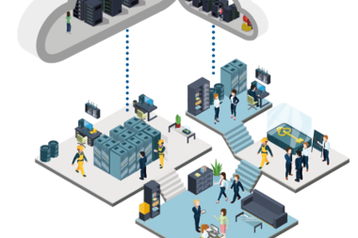The age-old saying ‘time is money’ has no better place than in the data center. Any outages, failures or just poor efficiency and outdated practices can cost an organization thousands, even millions in lost revenue, over time.
However, by implementing solutions focused on optimal performance an organization can prevent downtime, better manage power - and improve overall efficiency. This then translates into happy, productive employees and retained customers, but only if the right solutions have been chosen.
For organizations looking to identify the most essential data center solutions for data center managers to consider when bringing in any changes aimed at improving service delivery, here are our some good places to start:
DCIM
Data Center Infrastructure Management (DCIM) allows a data center to effectively manage its entire network and assets without wearing out shoe leather or counting off lists. This solution automates the management of all assets, resources, processes and people - supplying a rich set of information for a compute infrastructure.
A DCIM solution will monitor resources and processes feeding through information on:
- Capacity – is there enough space? Where is there flex?
- Power – do all the resources have sufficient power? Where are spikes predicted?
- Workflows – are the provisioning, remediation, and decommissioning workflows correct? What could be smarter, quicker, better?
- Efficiency – is the overall running of a data center efficient? Where are the pinch points?
All of this happens in real time, all the time, and is fed back to the data center manager to not only inform them of where money could be saved but also to identify potential failures before they happen. For example, if a rack is becoming overheated, the software can tell where and how the cooling system is failing. Once identified, the fault can be fixed with limited hassle – and limited client impact.
The above just skims the surface of what DCIM can do - it really has no bounds within the data center as AI and machine learning solutions become part of the DCIM package and add predictive capabilities to the mix.
AI Analytics
Artificial Intelligence analytics go hand in hand with DCIM within the data center. Through analytics, AI can predict and learn (through machine learning) everything from the causes of server room temperature surges to racks losing power from what cause. But it’s not just efficiency, AI has been proven to become a deterrent to cyber-attacks too.
The more sensors an organization can install around its network, the more intelligent the AI software can become. This growth in intelligence then means the AI can be more efficient when spotting faults or hacks (through unusual behavior patterns) and, in some cases, stepping in to eliminate them or alerting or advising how to rectify the issue before real harm is done.
But, it’s not just improving things internally: AI also factors in external effects such as weather patterns and puts implications in place to counteract their effects. This solution is worth investigating for an all-round, all-eventualities improvement in a data center.
GDPR
If you haven’t heard these four letters over the past year, where have you been?! For those who somehow aren’t aware, they stand for the General Data Protection Regulation which has been implemented throughout Europe and across the globe to help safeguard the personal data of EU residents.
A common misconception is that it only focuses on a small data set, not realizing the management of that data requires accountability for the entire chain from receiving the data to where it resides – with heavy fines should the regulation be flouted, even inadvertently.
In order to remain GDPR compliant, a solution is required that can manage and monitor the physical computing infrastructure that maintains all sensitive data. It should provide the ability to track within the physical infrastructure where the data resides, whether it is encrypted, and by what method and the means in which the data is transported, as well as who has interacted with the data.
That’s a tall order, without automation to assist.
DCSM
The foundation of Data Center Service Management (DCSM) originated in DCIM (automating data centers by managing racks, servers, cabling and power as well as the resources and constraints of those assets). This alone is great for data centers (and their managers), however, DCSM enhances this and enables businesses to manage more systems as well as a physical infrastructure with greater control.
The technology delivers context-sensitive workflows to manage and streamline processes in the data center. By managing all such processes DCSM can assign tasks which detail who, what, where, when and how data center changes should be handled. In turn, employees can perform their work easily, efficiently and to exactly to proper company policy. DCSM also allows you to synchronize information with other IT systems - by bridging these systems, everyone can have access to accurate and up to date information.
Ultimately, DCSM combines infrastructure management with data center work flow management and integrates them with other IT systems to bring increased efficiency and visibility in to your data center operations. Bringing these elements together will help you automate the management of all the services your data center provides, while improving alignment within the needs of your business: Resulting in increased efficiency, improved transparency and reduced costs.
Everlasting Solutions
Not only will these solutions help you to run a more efficient and lower-cost data center, but unlike some systems implemented in the past that weren’t built to last, these four solutions will continue to grow with your data center, giving back more efficiency and control than they take in management and cost.
It’s important to keep an open mind to the technologies and processes that help you adapt to the future and stay agile to current trends like as big data and cloud services. At the heart of it is making the most of applications and overall infrastructure: Optimization, doing more for less, never goes out of fashion.


